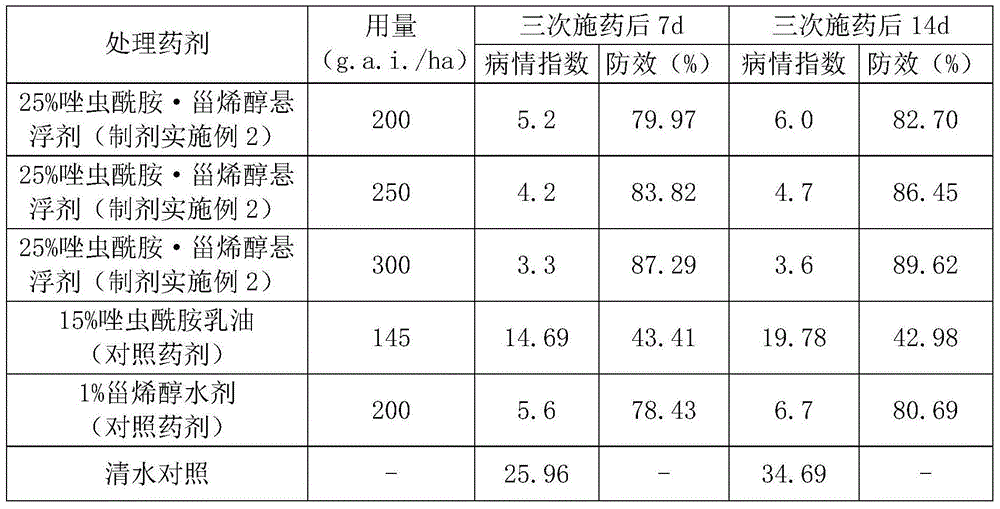Pesticide composition containing sterene alcohol and tolfenpyrad
A pesticide composition and a technology for tolafenamide, which are applied to pesticide formulations and their application fields, can solve the problems of inability to fundamentally control crop virus diseases, singleness, and unsatisfactory control effects, so as to delay the drug resistance of viruses and reduce the use of cost, the effect of avoiding the harm of a large-scale epidemic
- Summary
- Abstract
- Description
- Claims
- Application Information
AI Technical Summary
Problems solved by technology
Method used
Image
Examples
Embodiment 5
[0026] Formulation Example 5: 50% sterenol·tolfenpyrad water dispersible granules.
[0027] Steenol 35%, Tolfenpyrad 15%, sodium lauryl sulfate 5%, alkylphenol polyoxyethylene ether 10%, ammonium sulfate 2%, and kaolin make up 100%. Mix the above-mentioned active ingredients, wetting agent, dispersant, disintegrant and filler evenly, pulverize with an ultrafine jet mill, knead, and then add to a fluidized bed granulation dryer for granulation, drying, and sieving. 50% sterenol·tolfenpyrad water dispersible granules can be prepared.
[0028] Formulation Example 6: 80% sterenol·tolfenpyrad wettable powder.
[0029] Sterenol 50%, Tolfenpyrad 30%, Sodium dodecylbenzene sulfonate 10%, Polyoxyethylene glycerol fatty acid ester 5%, Kaolin makes up 100%. The above-mentioned effective ingredients, wetting agent, dispersant and filler are mixed, mechanically pulverized and then pulverized by airflow, and mixed uniformly, to obtain 80% sterenol·tolfenpyrad wettable powder.
Embodiment 1
[0030] Bioassay Example 1: Indoor combined virulence test of sterenol and tolfenpyrad on rice stripe leaf blight.
[0031] Cultivate potted susceptible rice varieties indoors. When the seedlings grow to 1 leaf and 1 heart to 2 leaves and 1 heart, the inoculation identification is carried out. Each pot cover is covered with a transparent cover, and the top is sealed with gauze. The amount of insects required is calculated according to 5 Laodelphax striatellus per seedling, and 2 to 3 instar Laodelphax striatellus (with a poisonous rate of about 40%) is connected. Deworming twice a day, so that the tested rice seedlings are evenly infected by the poison. Spray the formulated agents with different concentrations evenly on the test seedlings, each treatment 50 plants, 4 repetitions, 14 days after the administration, the disease condition is graded and the control effect is calculated, and the EC is used 50 Value to calculate the co-toxicity coefficient.
[0032] Table 1. Indoor combin...
Embodiment 2
[0036] Bioassay Example 2: Field efficacy test of compound sterenol and tolfenpyrad to control rice stripe disease.
[0037] Apply the pesticide for the first time 20-30 days after the rice is transplanted, and apply the pesticide again at an interval of 7 days for a total of 3 sprays. The survey results were conducted at 7d and 14d after the three administrations, and the disease index was counted to calculate the control effect.
[0038] It can be seen from Table 2 that after three application of 7d and 14d, 25% tolfenpyrad·sterenol suspension used 250-300g.ai / ha to control rice stripe blight better than 15% tolfenpyrad Emulsifiable concentrate and 1% sterenol aqua are used alone, and the control effect is above 85%. At the same time, the compound agent was not found to cause phytotoxicity to rice during the experimental investigation.
[0039] Table 2. Field efficacy test results of 25% tolfenpyrad·sterenol suspension against rice stripe disease
[0040]
[0041] In summary, the p...
PUM
 Login to View More
Login to View More Abstract
Description
Claims
Application Information
 Login to View More
Login to View More - Generate Ideas
- Intellectual Property
- Life Sciences
- Materials
- Tech Scout
- Unparalleled Data Quality
- Higher Quality Content
- 60% Fewer Hallucinations
Browse by: Latest US Patents, China's latest patents, Technical Efficacy Thesaurus, Application Domain, Technology Topic, Popular Technical Reports.
© 2025 PatSnap. All rights reserved.Legal|Privacy policy|Modern Slavery Act Transparency Statement|Sitemap|About US| Contact US: help@patsnap.com

